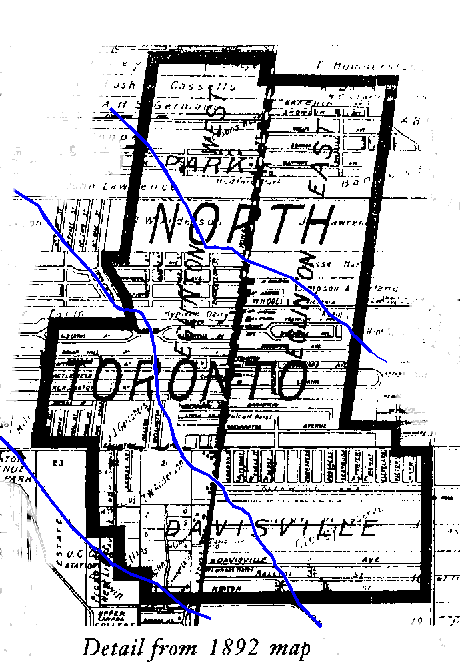
When the Town of North Toronto was incorporated in 1890, it was divided into three wards: Davisville, Eglinton East and Eglinton West. Most of the land in Eglinton East was still farmland. While some land had been subdivided, most of this was undeveloped, being held for speculation. Besides farmers, the residents included bankers, market gardeners, florists, blacksmiths, builders and humble widows. The older houses in the area show that most enjoyed a comfortable lifestyle. It was annexed to The Cityof Totonto in 1912.
The Sherwood Park area was known as Waterworks Park, until in 1920, when it was renamed. Until the 1890s, the people of North Toronto obtained their water from wells on their own properties, but by 1890 the municipality was building a pumping station at the springs on Roselawn Avenue, west of Avenue Road, (site of the transmission tower). However, an additional source of water was needed almost immediately. In 1902, The Town of North Toronto acquired part of what is now Sherwood Park for a new waterworks. The park area was added to in 1912 and later.
The town built a steam powered pumphouse on the site of the present Parks Department building, which for a time used natural gas from wells on the property. A.P. Coleman in “The Pleistocene of the Toronto Region” tells us that “One of the most interesting features of wells in the Toronto region is the frequent presence of natural gas coming probably in all cases from interglacial sand beneath a covering of clay. The two best known examples of this were at the North Toronto waterworks in Sherwood Park and at St. Augustine Seminary. At the waterworks the wells yielded gas from dry sand 50 feet below the surface under 40 feet of clay. For a time this was used beneath a boiler for the pumps ….The source of this gas is somewhat uncertain. It might be derived from the decay of interglacial plant material, which is widely distributed, or from bituminous shale at considerable depths beneath, as suggested by Col. Harkness. In either case the gas is retained by the impervious sheets of clay overlying the sand.”
There were six water wells situated just south of the powerhouse. Out of the hillside bubbled plenty of water year-round, which was held in circular cisterns until it was pumped to residences and businesses. In 1912, when North Toronto was annexed by the city, the watermains were linked up to the High Level Pumping Station on Poplar Plains Road, and the Sherwood Park pumping station was no longer needed. In 1926 a new sewer system was approved and the North Toronto Sewage Treatment Plant, in the Don Valley, was finished in 1929.
Don Ritchie, author of “North Toronto”, tells us that “South of Blythwood was the Stibbard farm. Cows grazed serenely in what is now Sherwood Park. (In fact. when sleighing was fast, the most exciting run from the end of Sheldrake Blvd. was what was called ‘the cowpath’, right down to the streamside; it was a narrow path, long since eroded and gone). Stibbard and his wife entertained often and well. There were ladies’ baseball games, probably, played right where the diamond and net now stand. And on at least one occasion, an elevated ropeway was run from tree to tree across the valley, and ladies swung over the stream in some sort of cradle, damn nearly revealing dimpled knees to the lustful male eyes below. More fun those days, better than television!”

